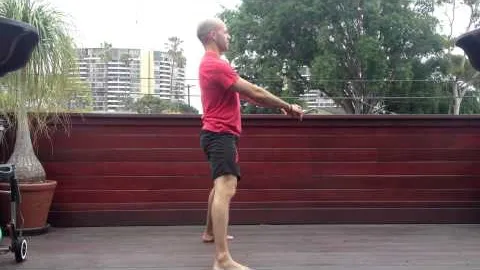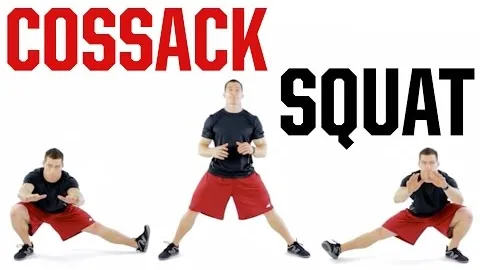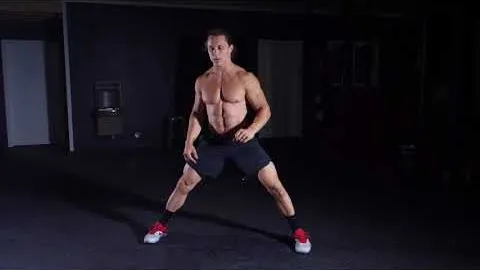Cossack Squat Exercise: A Guide to Performing and Benefiting From This Powerful Lower Body Workout
The Cossack squat, also known as the side-to-side squat or the lateral squat, is a challenging lower body exercise that targets various muscle groups, primarily the quads, glutes, and hips. This exercise, originated from the traditional Cossack warriors of Eastern Europe, is not only an effective way to build lower body strength and power but also provides numerous benefits for overall fitness. In this article, we will explore the correct technique for performing the Cossack squat, its benefits, and some variations you can incorporate into your workout routine.
Performing the Cossack Squat: Step-by-Step Guide
To perform the Cossack squat correctly, follow these steps:
- Starting Position: Stand with your feet wider than shoulder-width apart, toes pointing slightly outwards.
- Body Alignment: Keep your chest up, shoulders back, and core engaged throughout the exercise.
- Lateral Movement: Shift your weight to one side, bending that knee while keeping the other leg straight.
- Depth: Lower your body downwards until the bent knee forms a 90-degree angle, ensuring that your knee does not extend beyond your toes. Keep your torso upright and aligned with your bent leg.
- Return to Starting Position: Push off the bent leg and return to the starting position by extending the knee and pushing from the hip.
- Repeat on the Other Side: Perform the same movement on the opposite side, alternating between each repetition.
Common Mistakes to Avoid
To get the most out of the Cossack squat and prevent injuries, make sure to avoid the following mistakes:
- Knee Alignment: Ensure that your knees are aligned with your toes throughout the movement and do not collapse inward. This will help maintain stability and prevent unnecessary stress on the knee joint.
- Hip Mobility: Optimal hip mobility is crucial for performing the Cossack squat effectively. Make sure to focus on proper hip movement and range of motion to avoid compensations from other muscle groups.
- Maintaining Upright Torso: It is important to keep your torso upright and aligned with your bent leg to engage the targeted muscles fully. Leaning forward excessively can decrease the effectiveness of the exercise and increase the risk of injury.
- Choosing the Right Weight: Start with bodyweight or lighter resistance when first incorporating Cossack squats into your routine. Gradually increase the load as you become more comfortable and confident in your form.
Benefits of the Cossack Squat
The Cossack squat offers a wide range of benefits for individuals of all fitness levels. Some notable benefits include:
- Strengthens Lower Body Muscles: The Cossack squat targets the quadriceps, glutes, hamstrings, adductors, and calves, helping to develop strength and muscle tone in these areas.
- Improves Hip Mobility: By requiring deep hip flexion and rotation, the Cossack squat helps improve hip mobility. Enhanced hip mobility can positively impact athletic performance and reduce the risk of hip-related injuries.
- Enhances Balance and Stability: The lateral movement of the Cossack squat challenges your balance and stability, engaging smaller stabilizing muscles and improving overall body control.
- Activates the Core: To maintain an upright torso and body alignment during the exercise, your core muscles must engage and stabilize. This results in improved core strength and stability.
- Burns Calories and Increases Heart Rate: The Cossack squat is a compound exercise that targets multiple large muscle groups simultaneously. This leads to an increased heart rate, calorie burn, and improved cardiovascular fitness.
Variations of the Cossack Squat
Once you have mastered the basic Cossack squat, you can try incorporating these variations to add variety and challenge to your lower body workout routine:
- Weighted Cossack Squat: Hold a dumbbell or kettlebell in front of your chest to increase resistance and further challenge your muscles.
- Jumping Cossack Squat: Incorporate a jump into the Cossack squat by explosively pushing off the ground as you transition from one side to the other.
- Pulse Cossack Squat: Stay in the bottom position of the squat and perform small pulses by slightly raising and lowering yourself. This increases time under tension, further activating the muscles.
- Cossack Squat with Band: Place a resistance band around your thighs, just above the knees, to add lateral resistance, increasing the workload on the hip muscles.
Incorporating the Cossack Squat into Your Workout
Including the Cossack squat in your lower body workout routine can help you achieve your fitness goals. Here's how you can incorporate it effectively:
- Warm-up: Before performing Cossack squats, warm up with dynamic stretches, such as leg swings and hip rotations, to prepare your muscles and joints.
- Sets and Repetitions: Start with 2-3 sets of 8-10 repetitions on each side. Gradually increase the number of sets and repetitions as your strength and comfort level improve.
- Rest: Take 30-60 seconds of rest between sets to allow for muscle recovery and to maintain proper form. Adjust the rest period based on your fitness level and goals.
- Progression: As you become more proficient in the Cossack squat, increase the difficulty by incorporating variations or adding weight.
In conclusion, the Cossack squat is a powerful lower body exercise that provides a range of benefits, from strengthening the lower body muscles to improving hip mobility and overall body control. By following the correct technique, avoiding common mistakes, and incorporating variations, you can maximize the effectiveness of this exercise and enhance your fitness journey. So, incorporate the Cossack squat into your workout routine and enjoy the benefits it brings to your lower body strength and overall fitness.



